Offshore wind farm in South Korea with equipment manufactured by the country’s Doosan Enerbility (File photo, courtesy of Doosan Enerbility)
South Korea plans to team up with a global body established to cope with China’s rapid expansion in the world’s wind power industry while helping local companies increase their market shares in the sector.
The Ministry of Trade, Industry and Energy has decided to join the Global Offshore Wind Alliance (GOWA) with a schedule to complete the sign-up process in the second half, according to the government and energy industry sources on Sunday.
The alliance, founded by Denmark, the International Renewable Energy Agency (IRENA), and the Global Wind Energy Council (GWEC) whose members include China, was officially launched at COP27 in November 2022.
The GOWA, which currently has 20 member states such as the US and six wind power companies, aims to contain the dominance of China with local content requirements and subsidies for domestic companies.
“Korea has all the value chains for offshore wind power plants,” said a South Korean government official. “We are expected to benefit the most from the US and Europe’s moves to exclude Chinese products.”
The offshore wind power, along with photovoltaics, is considered a key for decarbonization with 248 gigawatts (GW) of the global wind power generation capacity scheduled to be installed by 2030.
CHINA’S DOMINANCE
China dominates the global wind power industry with four companies – Goldwind Science & Technology Co., Envision Energy, Windey Energy Technology Group Co. and Mingyang Smart Energy Group Ltd. in the world’s five largest original equipment manufacturer (OEM) list.
(Graphics by Dongbeom Yun)
The country increased its global new wind turbine market share to 65% last year from 53% in 2021, according to the GWEC. Its market share was likely to rise further to some 70% including components such as foundations and towers.
Its technology is also growing as the nation has applied for more than 170,000 international patents for wind power since 2015, quadruple those of the industry’s powerhouse Denmark, according to the Nihon Keizai Shimbun. China developed a wind turbine of 16 megawatts (MW), the world’s largest, last year.
“China installed offshore wind power plants for 77.1 GW last year alone, ten times those of the US,” said an industry source in Seoul.
TO TAKE ON CHINA TOGETHER
The GOWA asked South Korea to join when it was established in 2022 as the country is among a few capable of manufacturing not only key parts such as turbines, towers and foundations but also vessels for shipping them.
The country had been reluctant to participate in the alliance, however, due to concerns that domestic companies may miss opportunities in China, the world’s largest wind power market.
The government changed its stance as Chinese players expanded their presence in the peninsula.
Vensys Energy AG owned by Goldwind is poised to supply all the 64 turbines to a South Korean offshore wind farm for 365 GW under construction with an investment of 2.5 trillion won ($1.8 billion). Heongtong Group, China’s largest power and fiber optic cable manufacturer, will provide submarine cables for the project.
The US-China trade war expanded into the renewable energy sector, prompting South Korea to join the GOWA, industry sources in Seoul said.
“The GOWA indicates the global wind power market will be divided to reduce Chinese influences,” said one of the sources. “The government’s decision to join the alliance signals Korea’s breakup with the Chinese market.”
TO HELP WIND POWER INDUSTRY
The signup is expected to foster the South Korean wind power industry and increase exports, sources said.
Danish wind turbine maker Vestas Wind Systems A/S, a private member of the GOWA, relocated its Asia-Pacific headquarters to South Korea from Singapore in September last year to core parts and materials in the Northeast Asian country.
“Through the GOWA, cooperation will be elevated to a national level from a corporate level,” said Choi Deok-hwan, head of international cooperation at the Korea Wind Energy Industry Association. “Chances for large deals will increase.”
The country is home to major wind power component makers.
LS Cable & System Ltd. secured a 110 billion won deal to supply submarine cables for wind power to Taiwan this year. The company signed a 100 billion won deal in the US last week and a 282.1 billion won contract in Belgium.
LS Cable installs submarine cables (File photo, courtesy of LS Cable)
SK Ecoplant Co., a construction engineering and waste management firm, established a wind power component value chain with its subsidiary SK Oceanplant Co. SK Ecoplant constructs jackets, foundation parts, while SK Oceanplant manufactures offshore electrical substations.
The company also established an alliance with 24 local contractors.
“It was a move to secure yards to meet surging demand in Europe and North America,” said a company official.
Major shipbuilders – HD Hyundai Heavy Industries Co., Hanwha Ocean Co. and Samsung Heavy Industries Co. – are also expanding their capabilities to build special vessels.
Demand for wind turbine installation vessels grew as the capacity of offshore wind power generators rose to 10 MW per unit.
By Hyeon-woo Oh and Woo-Sub Kim
ohw@hankyung.com
Jongwoo Cheon edited this article.















